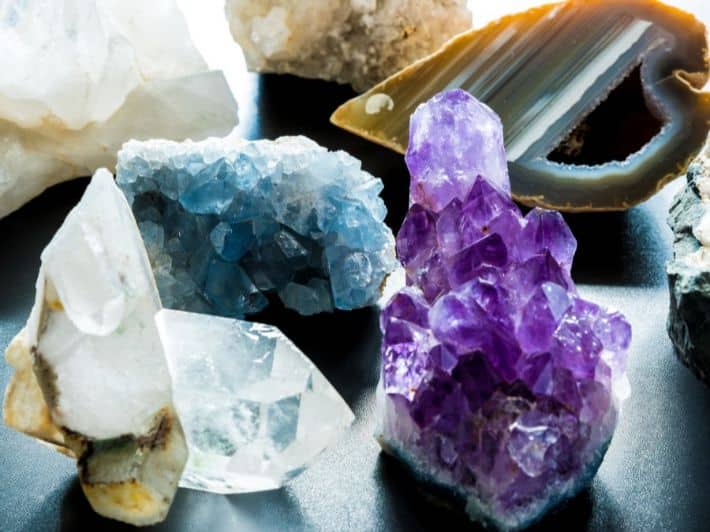For those interested in the culture of jewelry and gemstones

For those interested in the culture of jewelry and gemstones
For those interested in the culture of jewelry and gemstones
The benefits of precious stones in detail -
1- Definition of the precious stone:
A stone is called precious when it is characterized by its beauty and hardness, in addition to its color, rarity, final shape, polishing, and luster.
Weight is also important, as it determines the size of the stone, but not all stones are expensive.
Organic stones:
They are stones produced by living organisms such as plants and animals, such as:
1- Nacre produces pearls.
2. The structure of micro-aquatic animals produces coral.
3- Fossilized secretions trees produce amber.
4- Fossilized trees produce jet.
5- The teeth and tusks of some mammals form ivory.
3- Artificial stones:
The term synthetic stones was used for the first time by the US Federal Trade Agency to define gemstones that mimic natural stones in terms of chemical, physical and optical properties.
Artificial stones can be distinguished by examining them under a microscope, as they are complete and do not contain any impurities or scratches like those found in natural stones.
4- igneous and edematous rocks
Some rocks crystallize in magma or in gas bubbles inside volcanoes, such as zircon, topaz, and red sapphire.
5- Mineral stones:
Mineral stones are distinguished by their components, for example:
1- Quartz contains silicon.
2- Sapphires and emeralds contain oxide, chromium, and nickel.
3- Pearls contain calcium carbonate.
6- Igneous rocks:
They are flaming volcanic rocks. When cooled, the water interacts with its contents and crystals such as beryl are formed.
7- Metamorphic rocks:
They are rocks of volcanic or sedimentary origin that are transformed by pressure, heat, and interaction to produce jadeite, alabaster, and ruby.
8- Sedimentary rocks:
Sedimentary rocks were formed as a result of the fusion and solidification of some rock sediments and the remains of organic materials and other materials. For example:
Sandstone and silicate-rich minerals form amethyst (quartz) and agate.
9- Igneous rocks:
Igneous rocks are formed from volcanic magma ejected from volcanoes or solidified molten rock.
It often contains polymorphic crystals.
-:: Crystal Structure::-
1- What is a crystal:
A crystal is a solid substance that contains an internal arrangement of atoms, and this arrangement gives the crystal its description.
2- Shapes of crystals :
Crystals have many shapes, for example:
1- Monoclinic like gypsum
2- triclinic like sapphire
3- Quadrangular or ribs such as vesophontaite.
4- Hexagonal like aquamarine.
5- A cube like diamond and silver.
6- My eyes are straight like pearls.
7- isometric like garnet.
8- I don't look like ivory and amber.
-::Cutting Gems::-
1- Definition of cut gemstones:
It is the process of shaping and polishing gemstones to enhance their beauty and to remove impurities in some cases.
2- Stone cutting process:
Gemstones are shaped by honing them with a grinding wheel or wheel (grinding: grinding or polishing).
For smooth stones, sandstone wheels are used to rub and shape them.
As for the hardest stones, artificial honing wheels made of carburized carbondium are used
(silicon carbon).
3- Shapes of cutting gemstones:
1-Cutting in the shape of a button (cabochon)
2- Diamond cutting.
3- Emerald cut.
4- Straight cut.
5-Flat cutting.
6- Ornate cutting
7- Mixed or formed pieces.
-::Gemstone Shapes::-
1- The importance of shapes:
Each stone has a different structure, so it must be cut in a way that highlights its beauty, color and luster.
2- The most important forms of stones:
1- The ring.
2- Oval.
3- level.
4- The square.
5- The appraiser.
6- Rectangle.
7- The pillow.
8- Mixed.
9- The hanging one.
10- The navicular.
11- Scissors.
-::Sparkling Gems::-
1- What is luster?
It is the overall appearance of the stone as seen as a result of reflected light, which is related to the degree of polishing of the surface of the stone.
2- Optical properties :
The degree of refraction of light and the intensity of the color of a stone and their effect on
The degree of the apparent prismatic color of the stone, in addition to the transparency of some stones and their ability to show two different colors when viewed from different directions.
4- What is the critical angle?
It is the angle at which the total internal reflection of the stone occurs.
The light passes through the stone, so if the light passes through the stone, then if it passes within the critical angle (which is measured in relation to the right angle that intersects the surface) then it will pass through the stone. If it passes outside the critical angle, it will reflect inwards.
5- Stone measuring tools:
1_ Refractometer:
It measures the characteristics of a stone or its relative ability to refract light.
2_ polarimeter:
He makes a challenge if the stone is doubly refractive or mono refractive.
For example: Synthetic stones are characterized by double reflection, while natural diamonds are mono-refractory.
3_ binocular microscope:
It is used with a special dark field lamp to determine whether the stone is artificial or natural.
4_ Multiple tools and methods for measuring weight:
You measure the amount of attraction of a stone by weight.
For example: when a stone floats in a liquid, and its specific gravity is 4, and sinks in a liquid, and its specific gravity is 3, then the specific gravity of the stone must range between these two extremes, i.e. 5 and 3 approximately.
5_ spectroscope:
Dichroism is measured to determine the characteristics of the absorption spectrum.
6- Types of gloss:
1_ Shiny like mirrors.
2_ Earth or faded like Marshmallow (hydrated magnesium silicate).
3_ Diamond luster is like a diamond.
4_ Vitreous like sapphire.
5_ Metallic like silver.
6_ Hariri is like gypsum.
7_ Waxy like turquoise.
8_ oily like jadeite.
9_ Spruce is like amber.
-::Measuring the hardness of gemstones::-
1- Definition of Hardness:
It is important to measure the hardness of a gemstone and make sure it is scratch resistant before purchasing it.
Stones are classified according to their hardness and strength during cutting and use.
2- Definition of a banana scale:
It is a scale named after its inventor, German mineralogist Frederick Mohs. It classifies minerals according to their hardness and strength from 1 to 10. Its principle is that each stone on the scale scratches the stone before it, but does not scratch the one after it, and so on.
3- Banana scale:
1_ talc.
2_ Gypsum.
3_ Calcite.
4_ Fluorite.
5_ Apatite.
6_ Orthoclase
7_ quartz.
8_ Topaz.
9 _ Corundum.
10 _ diamonds.





